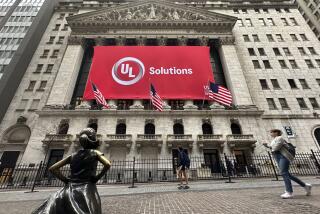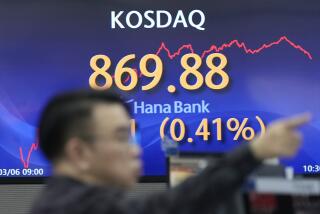JPMorgan’s loss from trading blunder could widen to $7.5 billion
NEW YORK — JPMorgan Chase & Co. revealed that losses from a trading blunder could widen to a whopping $7.5 billion as it reported that profit fell last quarter.
Wall Street’s reaction? Investors sent the bank’s stock surging 6% on Friday.
It’s been a rough couple of months for JPMorgan and its savvy chairman and chief executive, Jamie Dimon, since the bank disclosed that risky derivatives trades blew a hole — initially pegged at $2 billion — in what he calls the bank’s “fortress balance sheet.”
Dimon, credited with steering JPMorgan through the financial crisis largely unscathed, has been hauled before Congress and seen his credibility come under attack as Wall Street’s chief spokesman.
But on Friday, when the bank announced its second-quarter earnings, Dimon met face to face with analysts at JPMorgan’s Manhattan headquarters and told them much of what they wanted to hear.
The nation’s largest bank said the risky trading losses have widened to $5.8 billion so far this year — and, in a worst-case scenario, could grow by an additional $1.7 billion. But analysts now see how JPMorgan’s trading debacle may end, letting the bank focus on the industry’s other challenges.
“The size of the loss was toward the high end, but they got some clarity,” said Erik Oja, a banking analyst at S&P; Capital IQ.
JPMorgan had nearly unwound positions made by the trader whom Wall Street has dubbed “the London Whale,” Dimon said. Not only have the traders responsible for the losses left the bank with no severance, but they’ll lose two years of compensation — the maximum JPMorgan can claw back.
Ina Drew, who oversaw the bank’s Chief Investment Office, where the trading losses occurred, offered to forgo compensation that would have been subject to claw-back.
“We’ve learned a lot,” Dimon said. “I can tell you this has shaken our company to the core. And what happened here is that most of the management team went back and said, ‘Let’s redouble our efforts to make sure we’re running a great company.’ ”
Dimon also revived investors’ hopes the bank would buy back shares in the fourth quarter, pending regulatory approval. The bank shelved its planned buyback after it disclosed the trading losses May 10.
JPMorgan posted $5 billion, or $1.21 a share, in profit in the second quarter, down from $5.4 billion, or $1.27, in the second quarter last year. Trading losses aside, analysts said they were pleased with how the bank’s core businesses performed.
On Friday, JPMorgan shares gained $2.03, or 6%, to $36.07. But the bank’s stock is still off 11% since the big trading losses were revealed.
Since then, Dimon has worked to reassure investors after losing some credibility.
“He’s gained some of it back,” said Nancy Bush, a banking analyst and contributing editor at SNL Financial. But, she added: “Jamie is sort of on probation.”
A big question left unanswered Friday was what exposure JPMorgan might face from a wide-ranging investigation into alleged fixing of key interest rates, including the London inter-bank offered rate, or LIBOR.
British banking giant Barclays has agreed to pay more than $450 million in fines to American and British regulators, and casualties from the scandal include the bank’s chairman and chief executive.
Dimon would not say much about the LIBOR probe JPMorgan and more than a dozen other banks reportedly face.
“We’ll be totally open with regulators and investigators,” Dimon said. “It’s going to take a while, and not all companies are in the same position. I wouldn’t make too many assumptions at this point.”
Although Wall Street may have taken comfort in JPMorgan’s earnings announcement Friday, revelations that traders may have concealed the scope of the trading losses could raise more questions for regulators.
JPMorgan restated its first-quarter earnings, lowering reported profit by $459 million after discovering information suggesting “certain individuals may have been seeking to avoid showing the full amount of the losses,” the bank said in a filing with theU.S. Securities and Exchange Commission.
“The SEC would define this as fraudulent behavior,” said Mark Williams, a former Federal Reserve bank regulator who teaches finance at the Boston University School of Management.
“This revelation has increased the skepticism regulators have and also provided them with greater leverage” in tightening rules put in place by the Dodd-Frank financial overhaul, Williams added.
JPMorgan and Wells Fargo & Co. were the first big banks to report second-quarter earnings. Citigroup Inc.and Morgan Stanley are set to report Monday, followed byGoldman Sachs Group Inc. andBank of America Corp. later in the week.
Wells’ profit jumped 17% in the second quarter on strong loan and deposit growth. The San Francisco bank said it made $4.6 billion, or 82 cents a share, in the second quarter, up from $3.9 billion, or 70 cents, in the same period a year earlier.






